I've had a chance to upload some pictures, so you can see what Kenya is like. This is the entrance of Yehu.
It's interesting adjusting to the way things are done here - not only in the culture of Kenya, but the culture of a small non-profit that is trying to grow. It is expensive to hire full-time employees who have the intellectual capital they need to really make things happen, which is why they depend on the interns so much when we come here. The difficulty with this setup is that things take a long time to get done around here, so we may not finish all of the projects we begin before we leave.
There is so much that is not yet structured or set in stone, so it gives a lot of freedom in the work I do (a major change from the structure I was used to at the Census). I see a lot of opportunities to do exciting things out here once my main project is finished - mostly out in the field. One possibility is to take pictures of all of the clients and get information about who they are and what they plan to do with their micro loans. (Can you imagine how fascinating those mini interviews would be?) We could partner with Kiva and use these pictures and bios to really get the word out to more potential donors. Nowadays, online is the way to go.
Because Internet is so spotty, they don't rely on email very much, and printing is expensive too, so most everything in the corporate office is passed around with flash drives. They don't really have the funds to buy any extra computers for the interns, so we've all brought our own from home. (FYI, Africa is not very Mac compliant. Take note, Mac users.) Here is the desk/office area I share with Andi and Aaron (and probably soon to be a few more), and we're fixin' to dig into our lunch, which was conveniently brought to us in little black baggies that were tied shut.
Mmm…beef stew and rice…
Kenya’s Independence Day was on June 1, which meant we all got a 3-day weekend. We took advantage and headed south. We got to visit the Coast Coconut Farms factory to see the process of making coconut oil.
It was interesting! They husk the coconut…
Crack it open and shred all the meat out…
Then you dry out the meat and press out all the oil. Anyone want me to bring them back some? Oh, by the way, apparently it solidifies at 78 degrees Farenheit. That's not a problem, is it?
They even use the old shells to make charcoal. How many of you knew that coconut shell charcoal was a valuable commodity? (This is Luis Pope, one of the founders of Yehu and head of the Pope Foundation. I can’t say enough good things about him. He is such a generous man, beloved by many people in the Mombasa area. He’s taken over 20 trips to Kenya over the last 10 years.)
We also visited Mwambalazi, Yehu’s first branch (there are now six). My first trip into the bush. It was enlightening!
This is Mwambalazi's well. They use this water for drinking, cooking, and bathing.

The branch meetings take place in this little hut, and this man is the groundskeeper.
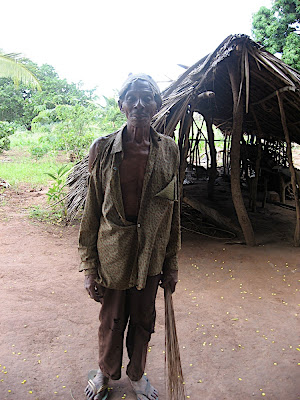
We visited one family and got to meet the three wives and all of their darling children.
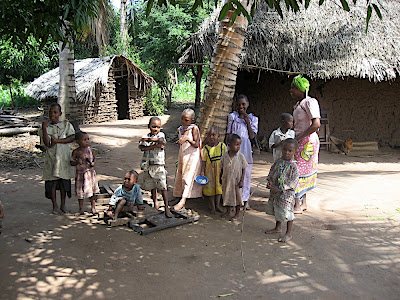
They weren’t afraid of us, for the most part…probably because of all the Yehu reps who come to the village.
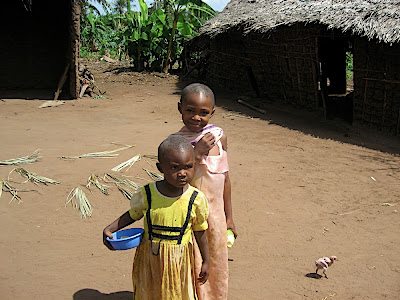
Smiling at the camera is not a process kids here have been conditioned to do, so they just stare at the strange silver box you point at them. I am very proud of this picture. I think it’s my favorite so far. What do you see in these little eyes?
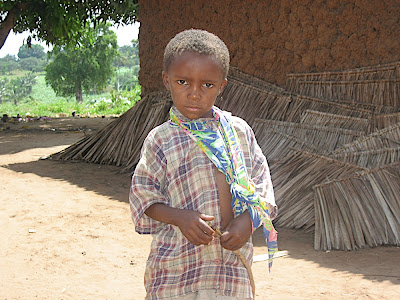
We also stopped by the beach. Let it be documented: this was the first opportunity I've ever had to dip my toes in the Indian Ocean.

The branch meetings take place in this little hut, and this man is the groundskeeper.
We visited one family and got to meet the three wives and all of their darling children.
They weren’t afraid of us, for the most part…probably because of all the Yehu reps who come to the village.
Smiling at the camera is not a process kids here have been conditioned to do, so they just stare at the strange silver box you point at them. I am very proud of this picture. I think it’s my favorite so far. What do you see in these little eyes?
We also stopped by the beach. Let it be documented: this was the first opportunity I've ever had to dip my toes in the Indian Ocean.
One day we took a walk after work before we jumped on a matatu and headed home. I just wanted to be out in the middle of everything, in slow motion. It's so much easier to experience the true character and personality of a place. We were able to get a closer look at the people, the street vendors and their wares, the scents and billboards...the general pulse of Mombasa. Cognizant of the fact that we already stand out, I tried to subtly (and sometimes not so subtly) snag some photos of the real world - Mombasa style.
Anywhere there is a pothole around here, the lid is missing. There's metal in that lid, which means quality material for a roof. Thus, the lids never last. Rather than leaving a gaping hole in the sidewalk for people to fall in, they just cover it up with something else!

This is the view from the bridge we cross to get back to Nyali. Since Mombasa is technically an island, it's all salt water.
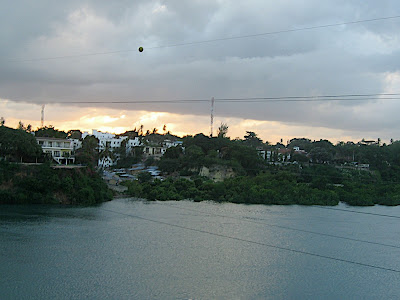
This is the view from the bridge we cross to get back to Nyali. Since Mombasa is technically an island, it's all salt water.
A very typical sight of Mombasa - a matatu (packed with people since it's rush hour).
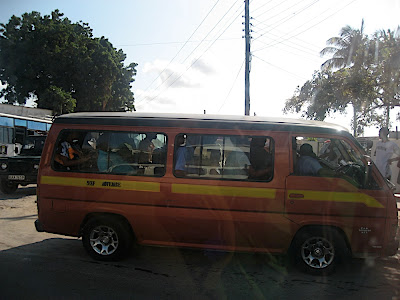
Another very common sight:
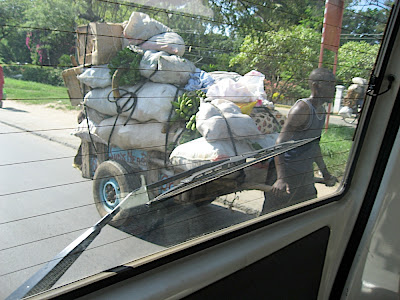
Another very common sight:
I often see these men pulling their overloaded carts. Most of them are barefoot. Often, their loads are so huge that they have two or three more men pushing the cart from behind. These are seriously heavy loads - you can see how hard they are straining, how much they are sweating, and how hardened their muscles have become from doing this every day. I even saw one guy hanging from the handles of one, putting all of his body weight into it, while three other guys lifted it from behind so they could get it started rolling. It was deeply humbling to see how hard they were all working, and then to think that this was all probably to take home the tiniest fraction of what we'd make in a half hour of sitting at a desk in an air-conditioned office in America. It was a powerful reminder - this is why I'm here. I can't help all of them, but I can help some.

Abby, it looks like you are having such an amazing time! Those little kids are the cutest ever, I love the picture of that little boy (btw, Grace would fit in well with the kids there, seeing how she responds to the camera :)). Love the updates!
ReplyDelete